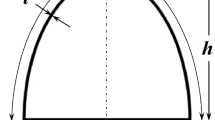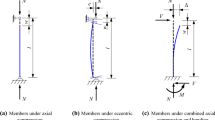Abstract
In this research, numerical study using finite elements has been conducted on cold formed carbon circular and square hollow steel sections subjected to torsional load. The numerical analysis has been performed with the validation of experimental square section using ABAQUS software. The study has been carried out for both slender and stocky sections. The circular hollow steel section has higher resistance to torsion as compared to square hollow steel section. The stocky section had higher torsional resistance as compared to slender section. As the thickness keeps on increasing from very slender to stocky section the percentage increase in torsional resistance of circular to square section keeps on increasing.
Access provided by Autonomous University of Puebla. Download conference paper PDF
Similar content being viewed by others
Keywords
1 Introduction
Carbon steel started to have an impact on the construction industry in the late nineteenth century when it became a widely used building material. Architects and engineers prefer hollow steel members in construction over open sections due to their high torsional rigidity, low drag coefficient, aesthetic appeal, interior space, etc. [1]. Closed hollow steel sections such as square, rectangle, circular etc. are fundamentally better than open sections at resisting torsional loads [2]. Ridley Ellis [3], Devi et al. [4] and Han et al. [5] conducted studies on rectangular, square hollow steel sections subjected to torsional load. Han et al. [5], Beck and Kiyomiya [6] carried out investigation on circular hollow steel section with pure torsion. As per the author's knowledge, a comparative study between circular and square steel hollow sections still has not been carried out. The aim of the study is to investigate the comparison between torsional behavior of circular and square steel hollow members based on the sections having the same perimeter, thickness and length. The finite element software ABAQUS [7] has been used for the study regarding numerical analysis of the hollow members subjected to torsion. The impact of varying thickness on the ultimate torsional load resisting capacity and the rotation angle at the failure of the sections were investigated using FEA modeling.
2 Finite Element Modeling Procedure
2.1 General
Numerical parametric investigation on circular and square hollow steel members has been performed using finite element software ABAQUS [7] by keeping the perimeter (P) and length (L) of the members constant and varying the thickness (t). The members are subjected to torsion. A reliable experimental result from literature [3] has been used to validate the finite element models. Once the model gets validated, parametric investigation is carried out with the use of material properties of steel from literature [3]. The following sections present the details of the FE study.
2.2 Geometry and Boundary Condition
For the purpose of validating both square and circular hollow section members, FE models were generated using the cross sectional dimension of square member from those presented by Ridley-Ellis [3]. Typical cross sections are as shown in Fig. 1. In order to apply boundary conditions, the endpoints of the finite element models have been coupled to two reference points by utilizing the “kinematic coupling” feature of ABAQUS [7]. The member was kept fixed at one end (denoted as RP-1) while the other end was solely restrained against translation and rotation along lateral axes (RP-2). Using the displacement control approach, twisting force was applied at the centroid of the model through RP-2 at a constant rate of 9.68 × 10–4 rad/sec. Similar boundary conditions are frequently used in the literature under torsional investigation [8, 9].
2.3 Finite Element Mesh
The models have been discretized using the shell element S4R [7] with reduced integration which is four noded. Each node has six degrees of freedom (3 rotations and 3 translations). It is generally reported in the literature that the S4R element can analyze both thin and thick hollow steel sections with a variety of cross sections, including square [10, 11], elliptical [12, 13] etc. As per the outcomes of the mesh convergence, the models utilized mesh sizes within the range ~12–15 mm, generating a total number of S4R elements in the range ~3000–4500 (Fig. 2).
2.4 Material Property
The FE models used the properties of steel reported in Ridley-Ellis [3]. The resulting stress strain values were transformed into true stress (σtrue) and true plastic strain (εpltrue) for use in Abaqus [7] using Eqs. (1) and (2).
where σengg = engineering stress, εengg = engineering strain, E0 = Initial young’s modulus.
2.5 Geometric Imperfection, Analysis and Validation
In the beginning, eigen value buckling study was performed to derive buckling mode shapes which were utilized to incorporate geometric imperfections in the finite element models. *STEP Static, general solver which is available in ABAQUS [7] has been utilized to carry out nonlinear analysis. Using varied values of local geometric imperfection, notably t/10, t/50, and t/100, it was checked how the torsional performance of the finite element models was affected by the geometric imperfection. As per the analysis, t/100 has been chosen for validation of the numerical models since the varied imperfection amplitude values did not significantly affect the overall response. The T-Ɵ curve obtained from the numerical model is in close agreement with that of literature [3], as can be shown in Fig. 3. Given the close similarity between the FE and experimental result, the current numerical modeling approach may be used to precisely predict cold formed hollow steel sections under torsional loading. Thus the validated finite element modeling procedures have been used for additional parametric investigation.
Validation of finite element model with experimental result of Ridley Ellis [3]
3 Parametric Study
In order to study the comparison between square and circular hollow sections, members having same perimeter were considered. In accordance with IS 4923 [14], steel square section with width B = 200 mm and a diameter based external rounded corner equal to 2t were adopted (see Fig. 1). Circular hollow section with diameter = 254.648 mm were considered. All FE model member lengths (L) were kept constant at three times the diameter of the circular hollow section. Thickness of the models was altered within 2–13 mm in order to accommodate considerable variation in slenderness.
4 Results and Interpretation
To analyze the comparative behavior of circular and square hollow steel sections, slender and stocky sections of both members were taken into consideration. The cross sections were classified as per Eurocode 3 [15]. Based on the numerical analysis carried out, few results have been highlighted as can be seen in Figs. 4, 5 and 6. With reference to Fig. 4 it can be interpreted that the circular section is better at resisting the torsional force than the square section as it has higher torsional capacity and higher rotation angle at failure. From Figs. 5 and 6, it can be referred that with increase in thickness of the section, the corresponding torsional capacity and rotation angle at failure also increases gradually for both circular and square hollow steel members.
5 Conclusion
A parametric study to analyze the ultimate torsional load resisting capacity of circular and square hollow members has been carried out by varying the thickness while keeping the perimeter and length of the members as constant by use of finite element analysis. According to the study, the following conclusions have been made:
-
a.
The circular hollow steel section has higher ultimate torsional resisting capacity as compared to square hollow steel section.
-
b.
With increase in thickness of the member, the stocky sections have higher resistance to torsion than that of slender section for both circular and square cross sections.
-
c.
As the thickness keeps on increasing from very slender to stocky section, the percentage increase in torsional resistance of circular to square section keeps on increasing.
References
Wardenier GJ, Packer J, Zhao JA, van der Vegte XL (2010) Hollow sections in structural applications
Ridley Ellis DJ, Owen JS, Davies G (2003) Torsional behaviour of rectangular hollow sections. J Constr Steel Res 59:641–663
Ridley Ellis D (2000) Rectangular hollow sections with circular web openings fundamental behaviour in torsion, bending and shear. PhD thesis University of Nottingham
Devi SV, Singh TG, Singh KD (2019) Cold-formed steel square hollow members with circular perforations subjected to torsion. J Constr Steel Res 162:105730
Han LH, Yao GH, Tao Z (2007) Performance of concrete filled thin walled steel tubes under pure torsion. Thin Walled Struct 45(1):24–36
Beck J, Kiyomiya O (2003) Fundemental pure torsional properties of concrete filled circular steel tubes. Doboku Gakkai Ronbunshu 60:285–296
Abaqus (2009) Abaqus/standard user's manual volumes I-III and ABAQUS CAE manual, version 6.9-EF1 dassault systems Corp, Providence, USA
Aisyah Mohd Zaifuddin S, Chen DH, Ushijima K (2017) Estimation of maximum torsional moment for multicorner tubes. Thin-Walled Struct 112:66–77
Shen K, Wan S, Mo YL, Song A, Li X (2018) Behavior of single-box multi-cell box-girders with corrugated steel webs under pure torsion. Part I: experimental and numerical studies. Thin-Walled Struct 129:542–557
Theofanous M, Gardner L (2009) Testing and numerical modelling of lean duplex stainless steel hollow section columns. Eng Struct 31:3047–3058
Patton ML, Singh KD (2012) Numerical modeling of lean duplex stainless steel hollow columns of square, L-, T-, and + - shaped sections under pure axial compression. Thin-Walled Struct 53:1–8
Silvestre N (2008) Buckling behaviour of elliptical cylindrical shells and tubes under compression. Int J Solids Struct 45:4427–4447
Silvestre N, Gardner L (2011) Elastic local post-buckling of elliptical tubes. J Constr Steel Res 67(3):281–292
IS 4923 (1997) Hollow steel sections for structural use—specification. Bureau of Indian Standards
EN 1993-1-5 (2005) Eurocode 3: design of steel structures–Part 1–5: plated structural elements. Eur Comm Stand Bruss
Author information
Authors and Affiliations
Corresponding author
Editor information
Editors and Affiliations
Rights and permissions
Copyright information
© 2024 The Author(s), under exclusive license to Springer Nature Singapore Pte Ltd.
About this paper
Cite this paper
Singh, T.B., Sachidananda, K., Singh, K.D. (2024). Numerical Investigation of Circular and Square Hollow Steel Section Subjected to Torsion. In: Swain, B.P., Dixit, U.S. (eds) Recent Advances in Civil Engineering. ICSTE 2023. Lecture Notes in Civil Engineering, vol 431. Springer, Singapore. https://doi.org/10.1007/978-981-99-4665-5_3
Download citation
DOI: https://doi.org/10.1007/978-981-99-4665-5_3
Published:
Publisher Name: Springer, Singapore
Print ISBN: 978-981-99-4664-8
Online ISBN: 978-981-99-4665-5
eBook Packages: EngineeringEngineering (R0)










